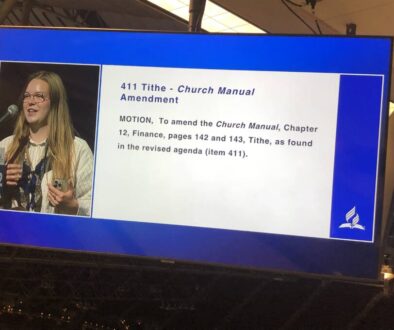North American Adventist Church Growth: The Untold Story
by Danny Bell
Church dignitaries anxious to capitalise on apparent gains in our worldwide movement have again given false impressions of the health of the Seventh-day Adventist Church. The virus was first picked up in Australia when Church leaders there began trumpeting results from the most recent Australian Census indicating the Adventist Church in Australia was the fastest growing denomination. Like a fever, these fantastic reports have circled the globe, despite the statistical evidence from the Church archives telling an entirely different and grim picture. [1]
Despite the warnings I gave in my earlier article, the virus is still alive. At a regional meeting recently I again listened in disbelief as a church representative brought to the attention of the congregation the news that North America was doing exceptionally well and that we should be proud of our movement. This was based on an article in USA Today, indicating that the Adventist Church was growing at the fastest pace of any Christian denomination in the country. [2] This led me to squirm in my seat, as I was witnessing yet another message of misinformation, giving average church members a false sense of security.
First consider a few facts from the general population in the US. A recent Gallup Poll indicated that 77 percent of Americans identify with Christianity and 18 percent have no religious affiliation. [3] This survey finding is consistent with other studies near this figure and the observations of many analysts that those who no longer believe have increased substantially. [4]
There is dispute about church attendance among American Christians. Researchers challenge the polls that give a rosy picture of 40 percent when, in fact, it is closer to 20 percent. [5] There is a disconnect between Americans and the Church. They are happy to buy the product, but don’t make them go to the store to get it.
So is the Adventist Church in the United States really doing that well? One way to measure this is to look at data available from the General Conference Office of Archives, Statistics and Research. [6] The latest information is for 2011 because 2012 data is still being compiled. I have applied the same parameters to the North American Division (NAD) which I did in the Australian Union Conference study, even though the NAD is much larger in scale and geography. The results are no less disappointing.
For the Adventist Church in North America the data show that the increase in membership was 15,224 souls for 2011. This net figure is after adding all of the increases such as baptisms, profession of faith, and transfers in and then subtracting the losses from deaths, dropped, missing and transfers out. [7] However, we still need to apply a couple more parameters to get a more realistic growth picture for the NAD in 2011.
Another way of looking at these data is called Kingdom growth, as I pointed out in the my article on the Australian Church. [8] The idea behind Kingdom growth is that the Church community increases by a non-believer becoming a Christian, leaving a deficit in the non-Christian community from which they came. For the purposes of illustration, if we were dealing in real growth terms it would look like this on a scoreboard:
| Christian community +1 | Non-Christian community – 1 |
So the Church’s gain is a decrease in the number of non–Christians. Knowing this, we need to also understand that it is estimated that about half of those who join the church annually come from Biological growth. [9] These increases come when we baptise our own children, those who have been brought up in the church. While it is a time for rejoicing when young people commit to Christ, it’s not true Kingdom growth. The non-Christian population has had no loss.
On way to explain this is by imagining that a church has 100 people attending regularly, 90 of whom are baptized and 10 who are youth who have not yet been baptized. If those 10 youth are then baptised, how has the church grown? The church is still 100 people and the community has not been impacted by the Gospel. Nothing has changed except inside the church.
The NAD’s net growth figure of 15,224 souls for 2011, therefore, can’t be classified as true Kingdom growth. If we concede half as being biological growth, that gives us a Kingdom growth net increase of 7,612 in 2011. To get a true picture in human terms we need to divide that figure among the 6,125 congregations of the NAD. This leaves us with an average increase of one-and-a-quarter persons per congregation. Sound cold and calculating? That’s reality, unfortunately.
If we were true to the idea of Kingdom growth, we could also say that the 5,556 souls that came in on profession of faith are not true Kingdom growth either. These members are deemed to have had a previous experience with Christ, before becoming Church members and, therefore, are not converts from the non-believing community. This adjustment tips the scales into negative territory where most Christian denominations in the U.S. clearly rate. The NAD’s ability to connect with the non-believing public ,therefore, is a losing battle, as its gains are among those who are already Christians, by an overwhelming majority.
I find most staggering the number of those who went missing during the year. The title “missing” means their local church does not know where they are. The 8,212 souls that just slipped out the back door into oblivion is a statistic that should shock us to our core. Building a more personal tracking system needs to be a major consideration.
I see retention as being part of the solution, but even with good retention rates, poor Kingdom growth is still a factor. As with Australians, most Americans identify with Christianity but are not attracted to church, as indicated by low attendance figures. They like what we are selling but our market stall is not user friendly. They like the potato salad but they didn’t trust the person who sold it to them.
The reality is that the Church in western society has become insular, self-centred, and unconcerned about a suffering, dying world. We prefer to stand at church doors and call out to the public rather than go out and get involved in the dirty business of befriending the scum of the earth. The fortress mentality is alive and well in our churches and until we realise that it’s not all about "going home to heaven" and "wishing Jesus would come," the sooner we can properly engage in the Master's business.
This is a mighty challenge for the NAD to seriously consider the current ways of doing things and ask if we are holding onto old forms of religion that are outdated and have lost currency with the masses. Are smaller, more personal efforts needed rather than large, ineffective and costly forms of evangelism? The public interest has clearly shifted away from what once attracted significant numbers.
Rather than pining for heaven and going home, we need to re-focus on what God still wants to do. Amos delivers a poignant final word and puts it better than I, for my conclusion: "What sorrow awaits you who say, 'If only the day of the Lord were here!' You have no idea what you are wishing for. That day will bring darkness, not light. In that day you will be like a man who runs from a lion—only to meet a bear. Escaping from the bear, he leans his hand against a wall in his house—and he’s bitten by a snake. Yes, the day of the Lord will be dark and hopeless, without a ray of joy or hope. I hate all your show and pretence – the hypocrisy of your religious festivals and solemn assemblies. I will not accept your burnt offerings and grain offerings. I won’t even notice all your choice peace offerings. Away with your noisy hymns of praise! I will not listen to the music of your harps. Instead, I want to see a mighty flood of justice, an endless river of righteous living." (Amos 5:18-24)
———-
1. Danny Bell, "What Did the Australian Census Really Tell Us About Church Growth?" Adventist Today [www.atoday.org], May 19, 2013.
2. Jeffrey MacDonald, "Adventists Back to Basics Faith is Fastest Growing US Church." USA Today, March 2011.
3. Don Gilleland, "50 years of change." Florida Today, January 2013.
4. Barnes & Lowry, "An Up Close Look at Church Attendance in America." Church LeadersWeb.
5. Ibid.
6. 2013 Annual Statistical Report, 149th Report of the General Conference of Seventh-day Adventists for Year Ending December 31, 2011.
7. Ibid.
8. Bell, Ibid.
9. There is no real way of measuring this except by anecdotal evidence. I understand that many may query this but if we look through our publications and baptisms we attend we can safely say that 50 percent is a conservative estimate. In reality it is much higher for many churches. It would be interesting for there to be some compiled data on this but I have yet to find any.
Danny Bell lives in Western Australia. He has been a pastor, chaplain, family court mediator, counsellor and editor of Trench Mail, a men’s ministry publication. He is currently leading a church plant called Lion Hearts which focuses on attracting men. His passion lies in making the Church relevant to the Church’s largest unreached people group—men.



